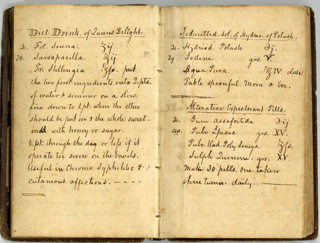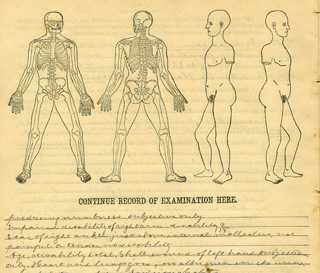Pestilence, Potions, and Persistence Early Florida Medicine
Physicians
Florida has employed healers of many sorts—physicians, pharmacists, shamans, and makers of home remedies—from the colonial and territorial years, through the development of the modern state. Doctors were some of the most prominent immigrants to Florida, and access to medical care was essential, if often hard to come by, in the more remote regions of the young state.
Pioneer physicians often found that medical practices alone did not provide enough dependable income, and most pursued other professional ventures such as establishing plantations or serving in public office.
Dr. John M. W. Davidson Journal
In 1843, Dr. John M. W. Davidson of Gadsden County began recording medical recipes and treatments in a small, leather-bound notebook.
Davidson was a family practitioner and farmer who lived and worked in Gadsden County for more than 50 years. The 126-page journal reveals a glimpse of the knowledge and concerns of a pioneer physician in early Florida, including recipes for medicines, diet supplements, tinctures, salves, and treatments for illnesses as varied as colic and typhoid fever.
Civil War Veterans Pension Claims Examinations by Dr. Thomas H. Hammond
This medical journal kept by Dr. Thomas H. Hammond of Oxford, Florida, between 1896 and 1903 details medical examinations of Civil War veterans required for approval of pension applications or for an increase in an existing pension allowance.
The examinations were conducted for veterans of the Civil War and a smaller number of veterans who served later as required by the United States Department of the Interior, Bureau of Pensions.
For each individual examined, the reports include such information as type of pension claim (original, increase, or restoration); pension claim number; claimant's name, rank, company, and regiment; post office address of examining surgeon and claimant; cause of disability; current pension amount; claimant's statement as to reason for claim; and the physician's examination report, including pulse rate, respiration, temperature, height, weight, age, and a detailed narrative description of wounds, conditions, and disabilities. In some later cases, Dr. Hammond also recommends a pension amount.
The journal shows both the daily activities of a physician performing essential work, in this example on behalf of the federal government, and the ailments and physical needs of men in rural Florida in the last decade of the 19th century.
"Ode to Health"
This small notebook of writings about health and medicine describes many common medicines of the late 19th century as poison.
Although the notebook was included in a collection along with the veterans pension journal of Dr. Thomas H. Hammond of Oxford, Florida, the notebook does not appear to be in the same hand as that of Dr. Hammond's medical examinations.
It may have been written by Dr. George Washington Wood, who received his medical degree from Birmingham Medical College and later settled in Oxford, Florida, where he came into possession of the Hammond medical journal.

 Listen: The Blues Program
Listen: The Blues Program


